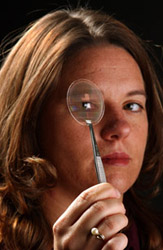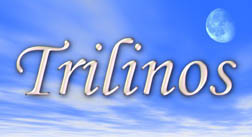|
|
||
| News Center |

|
|
|
|
||
|
|
||
News Release Archive | Awards | ||||||
|
FOR IMMEDIATE RELEASE
Sandia wins two R&D 100 AwardsALBUQUERQUE, N.M. — Two Sandia National Laboratories research teams have won R&D 100 Awards in the annual competition sponsored by the Chicago-based R&D Magazine. One award is for a new process of growing gallium nitride on an etched sapphire substrate, called cantilever epitaxy, which promises to make brighter green, blue, and white light emitting diodes (LEDS) — solid state lighting. The other is for the creation of the software framework and library Trilinos, which provides broad-ranging, robust, and high-performance capabilities for solving numerical systems at the heart of many complex multiphysics engineering and scientific applications. R&D Magazine annually gives the awards to the top 100 industrial innovations worldwide. This year Department of Energy (DOE) labs — of which Sandia is one — have won a total of 34 R&D 100 awards, says Jeannette Mallozzi, the magazine's managing editor. Winners will be presented plaques at a formal banquet in October at Chicago's Navy Pier. "The research groups winning these awards at Sandia this year are truly innovative and on the cutting edge of science," says Sandia President C. Paul Robinson. "The cantilever epitaxy process offers the potential for longer-lived and better performing LEDs. Trilinos has had a major impact on Sandia's engineering modeling and simulation capabilities over the past several years, and with its public licensing we are extending that to broad national impact." Here are brief descriptions of the two winning Sandia technologies. Cantilever epitaxy
Colored LEDs are of interest for displays and even higher-power lamps like traffic lights. A national initiative is now underway to develop solid-state sources for high-efficiency white lighting. The cantilever epitaxy process of growing LEDs may help meet those needs. "Our new process eliminates many of the problems that have limited the optical and electronic performances of LEDs, previously grown on sapphire/gallium nitride substrates," says Carol Ashby, one of the inventors on the project. Over the past several years LEDs have been grown with various combinations of gallium nitride alloys on sapphire substrates. However, the atoms of the two materials do not line up perfectly due to differences in natural lengths of the bonds in their respective crystal lattices. Regions of imperfections, called dislocations, accompany this lattice mismatch. These dislocations limit LEDs' brightness and performance. The new cantilever epitaxy process reduces the numbers of dislocations, giving the potential for longer-lived and better performing LEDs. It also means that LEDs grown on the patterned sapphire/gallium nitride substrates can produce brighter, more efficient, green, blue, and white lights than previously accomplished. David Follstaedt, another inventor on the project, says that because of the reduction in dislocations, the cantilever epitaxy process shows "great promise for making a superior substrate for light-emitting devices" and has potential for applications to a wide variety of electronic devices and GaN integrated circuit technology." Transmission electron microscopy (TEM) and scanning electron microscopy (SEM) is used to determine the amount of dislocations eliminated through the cantilever epitaxy process. The cantilever epitaxy program at Sandia is part of an internal three-year $6.6 million Laboratory Directed Research and Development (LDRD) Grand Challenge. Funding for the program also comes from a grant from the DOE Office of Building Technologies for a collaborative project with Lumileds Lighting, a joint venture between Agilent Technologies and Phillips Lighting.
Trilinos is part of a broad effort on the part of national laboratories, industry, and academia to establish high-fidelity computational modeling and simulation as an approach to engineering and scientific understanding so that it becomes an equal partner with the most basic approaches of theory and experiment. Trilinos provides a common enabling solution to one of the most difficult problems in creating these simulations: How can one solve the massive and complex systems of equations required, and do so in a way that "scales" all the way from laptop computers to the most powerful and complex parallel computers in the world? Trilinos has become tremendously successful at addressing this "solver problem" and has become, for example, a critical enabler for the diverse simulation codes that support almost every major engineering discipline within The Department of Energy's Advanced Simulation and Computing (ASC) program. Trilinos, led by Mike Heroux, is under development at both Sandia/New Mexico and Sandia/California, with some 24 researchers involved in the project. Trilinos offers what is probably the largest and most complete scalable solver capability in the world, and it is freely available to the public. Meaning "string of pearls" in Greek, Trilinos has an architecture in which object-oriented packages, each of which provides a particular solver capability, are strung together like pearls on a necklace and represent more than the sum of the parts. Trilinos began as 3 packages, has rapidly expanded to 20, and continues to grow. Computational researchers and software developers find Trilinos attractive because they need only focus on those aspects of development that are unique to their package. Each Trilinos package is a self-contained, independent piece of software with its own set of requirements, its own development team, and its own group of users. Because of this, Trilinos is designed to respect the autonomy of packages. Trilinos offers a variety of ways for a particular package to interact with other Trilinos packages. It also offers developers a set of tools for building on multiple platforms, generating documentation, and multi-platform regression testing. Sandia Media Relations Contact: Chris Burroughs, (505) 844-0948, coburro@sandia.gov Sandia technical contact for cantilever epitaxy : Carol Ashby, (505) 844-2303, clashby@sandia.gov Sandia technical contact for Trilinos : Micheal Heroux, (320) 845-7695, maherou@sandia.gov
| ||||||
|
Back to top of page News Releases | Publications | Resources | Multimedia Gallery |
||||||
|
|
||||||
|
|
||||||

